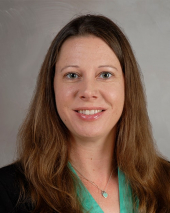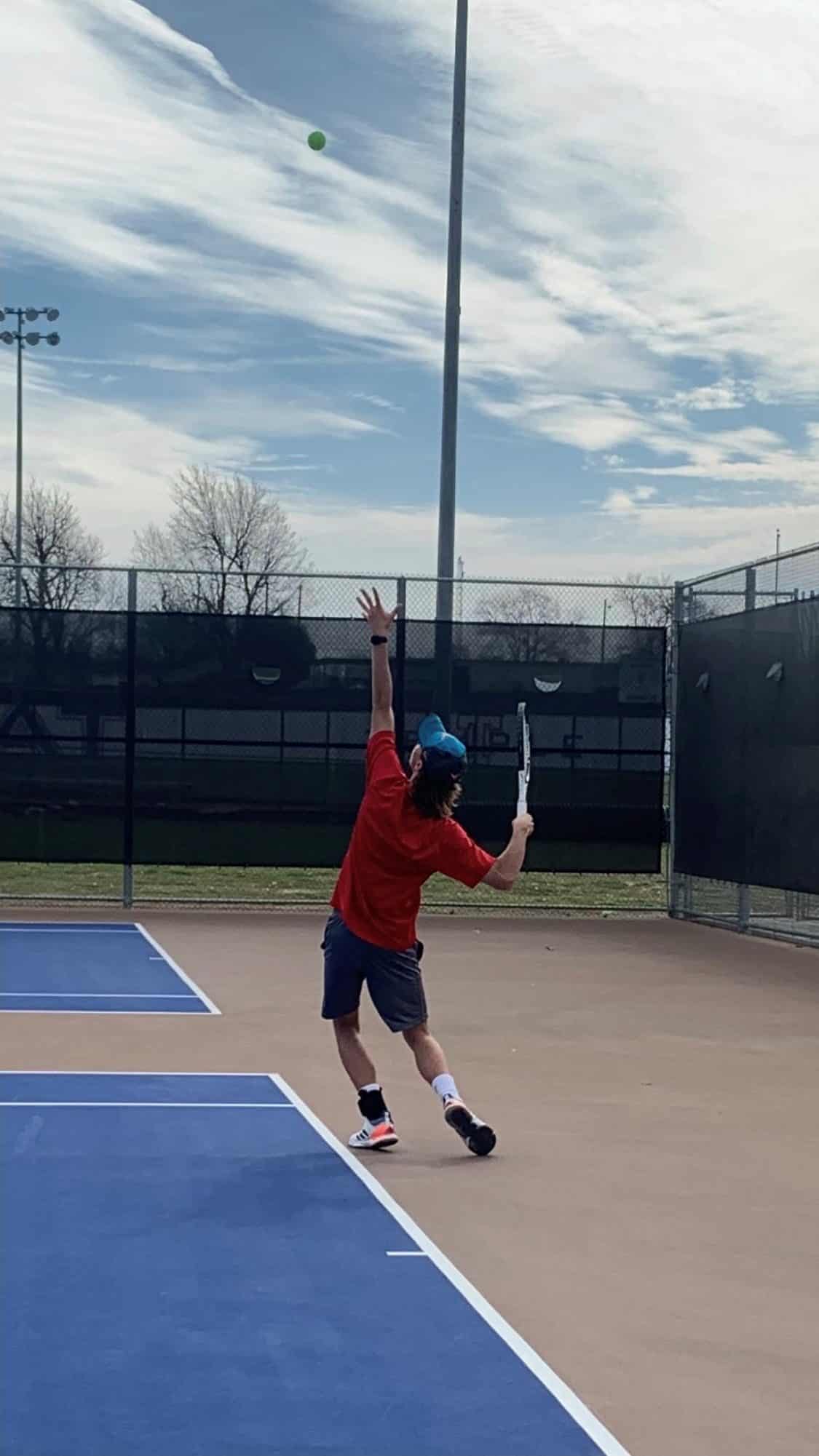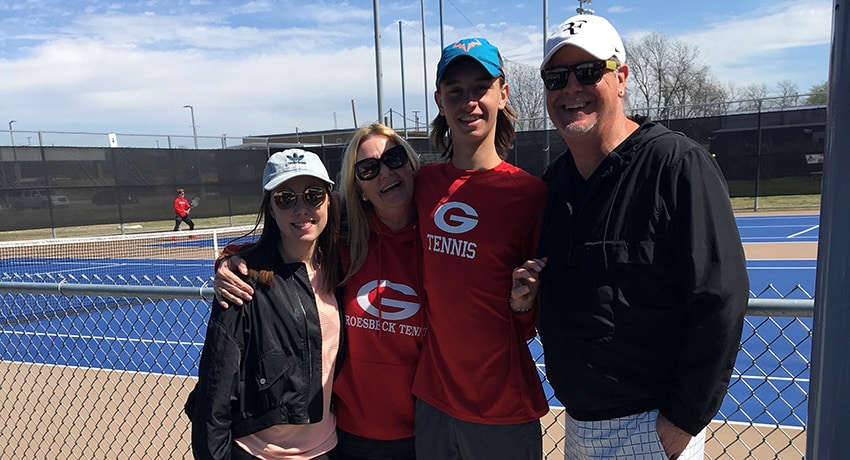Since he was 4 years old, a major part of Luke Henley’s life has been tennis. To play professionally one day, Luke is on the right track – even after multiple surgeries on one of his femurs.
Emergency surgery
At 16 years old, Luke took a job at a local tennis store. The position was a perfect fit. He was able to share with customers his love of the sport and spend time with friends who also worked there.
Everything changed with a one-car crash while on the way to lunch with his coworkers. Although he wasn’t driving, Luke sustained several injuries.
“We had crashed into a metal pole, and I was knocked out in the process. I woke up when a passerby pulled me out of the car,” said Luke. “I remember I was bleeding, there was glass everywhere, and I was so disoriented that my first thought was that I needed to get back to work before my lunch shift ended.”
After being removed from the car, Luke instantly knew something was wrong. His right leg was limp and unable to move. The extremities that once could easily guide him around a tennis court would not allow him to take one step.

Paramedics brought Luke to the nearest hospital, where he would ultimately undergo emergency surgery with Lindsay M. Crawford, MD, pediatric orthopedic surgeon with UT Physicians and assistant professor of orthopedic surgery at McGovern Medical School at UTHealth.
“I first met Luke and his parents in the pre-operative area to explain the extent of his injuries,” said Crawford. “After scans, we concluded that he had sustained a femoral neck fracture, at the top of the thigh bone at the hip joint. We needed to get that stabilized and aligned quickly and correctly.”
Belinda Henley, Luke’s mother, was devastated to learn the extent of his injuries.
“Luke and his dad have been on the tennis court since Luke was 4,” said Belinda. “That first night in the emergency room, we did not have a clue what would be the outcome, but we knew immediately after the first meeting with Dr. Crawford that we were in good hands.”
Immediate surgical intervention was necessary due to the risk of Luke’s hip possibly losing blood supply and causing long-term issues, such as severe arthritis or the need for a total hip replacement.
Of course, Luke’s first thought was of his budding tennis career.
“Dr. Crawford comforted me in that moment. She told me that it wouldn’t be fast, but I could get back to normal after the surgery if I did everything I needed to do,” he said.
His surgery included plates and screws to help stabilize his femur. Crawford also opened up his hip joint to drain the excess blood and reduce the pressure on it.
Recovery from surgery included one week in the hospital and then physical therapy. The once active teenager was bound to a wheelchair for a few weeks, and then crutches for six months.
With hard work and regular appointments with Crawford, Luke was back to normal in a little over a year. He was even back on the tennis court, with a bit of help from a partner.
“After surgery, Dr. Crawford recommended going into doubles first once I was ready to play again. Having a partner was a big change for me because I don’t like to depend on someone else to win, but it did mean less movement around the court, which is what I needed at the time,” said Luke.
Follow-up procedure
With a year and a few months under his belt from his surgery and his mobility completely returned, it was time for Luke to have the hardware in his leg removed.
“It’s standard to remove implants in the hip area for younger patients just in case they would ever need hip surgery in the future,” said Crawford.
During his recovery, Luke’s femur was able to stabilize, and the plates and screws were no longer necessary.
Unlike the first, this surgery was planned, and recovery was much smoother.
“My physical therapy after my second surgery wasn’t as intense as the first time,” Luke recalls.
All was well until three months post-operation. While fishing at his family’s lake house, he hit a major stop in his recovery.
“I took a step and realized immediately that my leg could no longer support me, so I just started crawling,” said Luke.
Ultimately, he would learn that his femur had broken for a second time after a single step.
Final surgery
Luke went in for X-rays immediately, but with a heavy heart.

“I remember it felt like years to get the X-rays done and wait to see Dr. Crawford. I wanted to go to college to play tennis the next year. I wanted to go professional,” said Luke. “As soon as I saw her come in the room with another doctor, I thought ‘Well, this is it, no more tennis,’ and started to cry.”
The news was not great – his femur was broken again, and he would need another surgery. That, however, was not the reason Crawford invited another doctor into the room.
“I brought in one of my residents from McGovern Medical School that happened also to play tennis in college to help me console Luke,” she said. The resident is also an assistant professor in the Department of Orthopedic Surgery at McGovern Medical School.
Together, they gave him examples of other athletes who had sustained major injuries and still went on to play their respective sports professionally.
“She made me feel like it was possible to get back, but made sure I knew that it wouldn’t be easy,” said Luke.
His case is considered atypical and unexpected. After an implant is removed, a small hole is left in the bone. With time, the bone can regenerate in that area. Unfortunately for Luke, that did not happen, and his hip fractured in a different location due to the stress.
For this surgery, Crawford placed a large rod both outside and inside his damaged femur and two pins through it to secure the hardware in place.
Determined for this to be his last surgery for a while, Luke dedicated himself to his recovery. For a while, it seemed like he could not walk without a pronounced limp, which hurt his spirit more than anything.
“Therapy was easy since I had already been through it twice before, but mentally, it was crushing. It seemed like my goals were impossible,” he said.
After a few months, those hopes that seemed so unattainable were finally within his reach.
Recovery
Luke made a full recovery with the help of physical therapy and consistent check-ins with Crawford. What started as a traumatic experience has led to a lifelong connection and a new purpose in life.
“She inspired me. Her care and how she was able to comfort me through such a hard time helped guide my decision to become a doctor one day,” said Luke.
Heartened by his choice to enter into the medical field, Crawford wrote him a letter of recommendation for a college scholarship.
“To this day, I do not know if she will ever realize the admiration, love, and respect we all have for her as a surgeon and our friend,” said David Henley, Luke’s father.
Currently, Luke is living his dream of a collegiate tennis career at Bethel College in Kansas.


